This article has been reviewed according to Science X's editorial process and policies. Editors have highlighted the following attributes while ensuring the content's credibility:
fact-checked
reputable news agency
proofread
A total solar eclipse races across North America as clouds part along totality
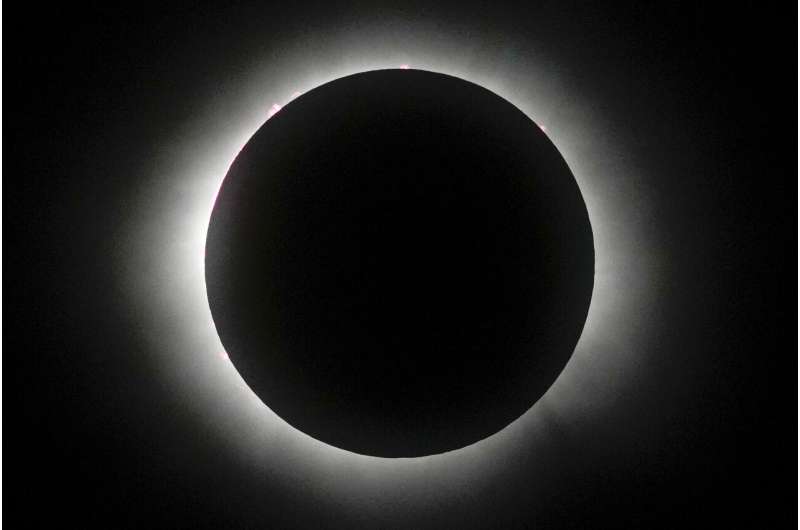
A chilly, midday darkness fell across North America on Monday as a total solar eclipse raced across the continent, thrilling those lucky enough to behold the spectacle through clear skies.
Eclipse mania gripped all of Mexico, the U.S. and Canada, as the moon swept in front of the sun, blotting out daylight. Almost everyone in North America was guaranteed at least a partial eclipse, weather permitting.
It was the continent's biggest eclipse audience ever, with a couple hundred million people living in or near the shadow's path, plus scores of out-of-towners flocking in.
Clouds blanketed most of Texas as the total solar eclipse began its diagonal dash across land, starting along Mexico's mostly clear Pacific coast and aiming for Texas and 14 other U.S. States, before exiting into the North Atlantic near Newfoundland.
Just east of Dallas, the hundreds gathered at Mesquite's downtown area cheered and whistled as the clouds parted in the final minutes before totality. As the sun finally became cloaked, the crowd grew louder, whipping off their eclipse glasses to soak in the unforgettable view of the sun's corona, or spiky outer atmosphere, and Venus shining brilliantly off to the right.
City officials reminded everyone that the last total solar eclipse in these parts was the 1870s, making this one all the more special. Eclipse-themed music was turned off as the big moment approached.
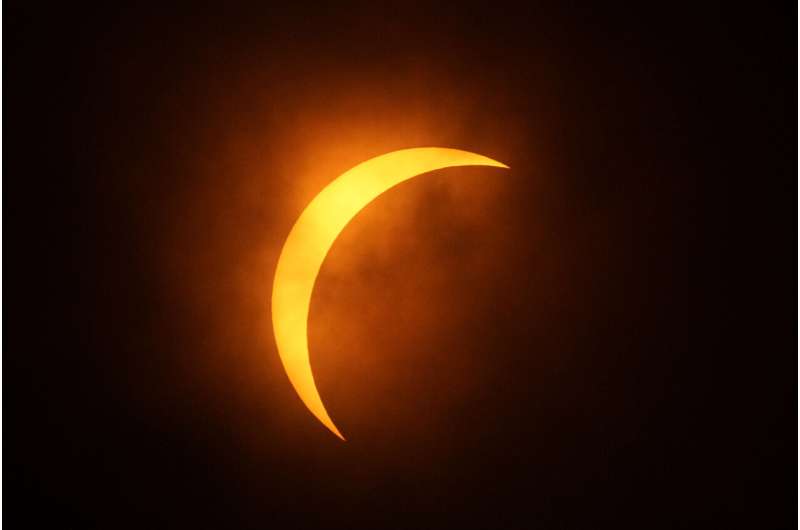
"Oh God, it's so dark," marveled Aiyana Brown, 14, who watched alongside her grandfather, Mesquite Mayor Daniel Aleman Jr. "I'm a huge science nerd, and this is amazing."
The weather also cooperated at the last minute near Austin. "I will never unsee this," said Ahmed Husseim of Austin, who had the eclipse on his calendar for a year. Husseim and his family were among hundreds who gathered on the lawn of Southwestern University in Georgetown, Texas, with blankets, lawn chairs and country music.
Arkansas and northeast New England were the best bets in the U.S., going into Monday's spectacle. New Brunswick and Newfoundland in Canada also looked promising.
The show got underway in the Pacific before noon EDT. As the darkness of totality reached the Mexican resort city of Mazatlán, the faces of spectators were illuminated only by the screens of their cellphones.
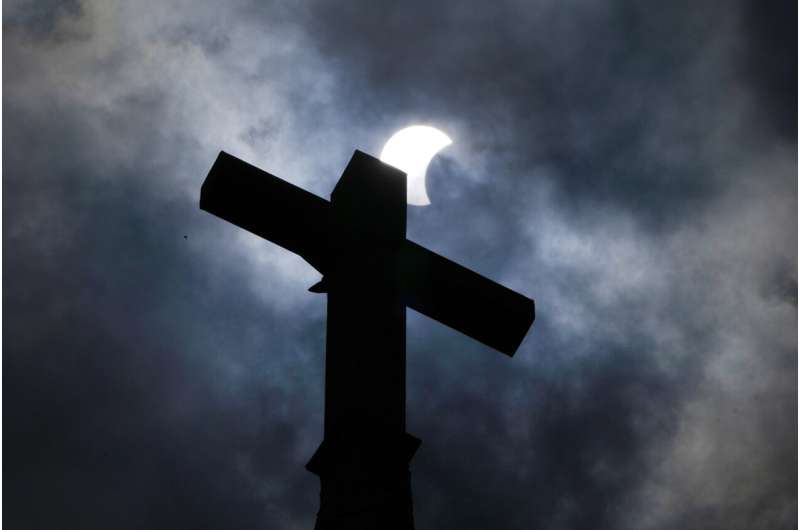
The cliff-hanging uncertainty added to the drama. But the overcast skies in Mesquite near Dallas didn't rattle Erin Froneberger, who was in town for business and brought along her eclipse glasses.
"We are always just rushing, rushing, rushing," she said. "But this is an event that we can just take a moment, a few seconds that it's going to happen and embrace it."
A festival outside Austin wrapped up early on Monday because afternoon storms were in the forecast. Festival organizers urged everyone to pack up and leave.
Sara Laneau, of Westfield, Vermont, woke up at 4 a.m. Monday to take her 16-year-old niece to nearby Jay Peak ski resort to catch the eclipse after a morning on the slopes.
"This will be a first from me and an experience of a lifetime," said Laneau, who was dressed in a purple metallic ski suit with a solar eclipse T-shirt underneath.

At Niagara Falls State Park, tourists streamed in under cloudy skies with wagons, strollers, coolers and lawn chairs. Park officials expected a large crowd at the popular site overlooking the falls.
During Monday's full eclipse, the moon slipped right in front of the sun, entirely blocking it. The resulting twilight, with only the sun's outer atmosphere or corona visible, would be long enough for birds and other animals to fall silent, and for planets, stars and maybe even a comet to pop out.
The out-of-sync darkness lasts up to 4 minutes, 28 seconds. That's almost twice as long as it was during the U.S. coast-to-coast eclipse seven years ago because the moon is closer to Earth. It will be another 21 years before the U.S. sees another total solar eclipse on this scale.
It will take just 1 hour, 40 minutes for the moon's shadow to race more than 4,000 miles (6,500 kilometers) across the continent.
-
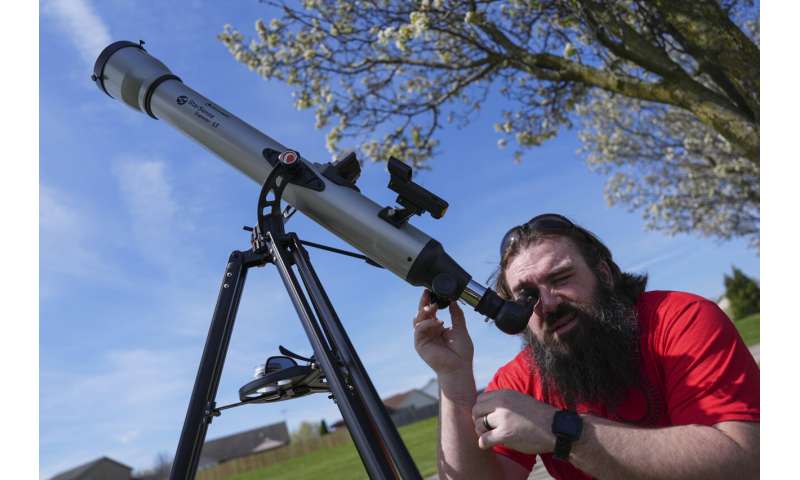
Kenny Riehl, of Solon, Iowa, adjusts a telescope while looking at the sun before a total solar eclipse, Monday, April 8, 2024, in Trenton, Ohio. Credit: AP Photo/Joshua A. Bickel -
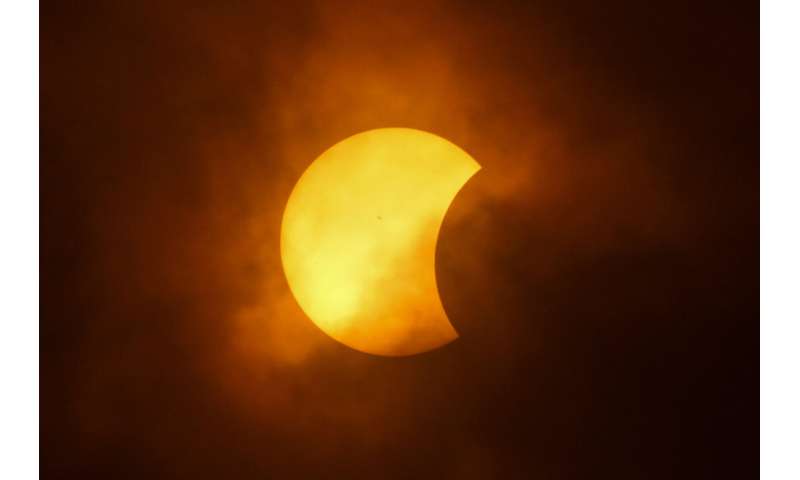
The moon partially covers the sun during a total solar eclipse, as seen from Eagle Pass, Texas, Monday, April 8, 2024. Credit: AP Photo/Eric Gay -

Karine Rodriquez, right, sits with her son Yurem, left, and daughter Aranza, center, as the moon partially covers the sun during a total solar eclipse, as seen from Eagle Pass, Texas, Monday, April 8, 2024. Credit: AP Photo/Eric Gay -

Jordan Elliott smiles as she watches with solar glasses as the moon starts to cross in front of the sun during a total solar eclipse Monday, April 8, 2024, in Carbondale, Ill. Credit: AP Photo/Jeff Roberson -

A patron looks up at the sun during an solar eclipse during a practice round in preparation for the Masters golf tournament at Augusta National Golf Club Monday, April 8, 2024, in Augusta, Ga. Credit: AP Photo/Ashley Landis -
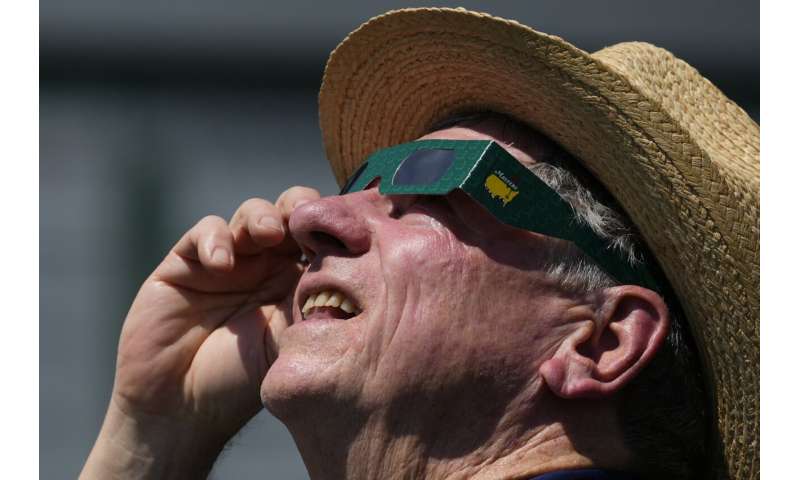
A patron look up at the sun during an solar eclipse during a practice round in preparation for the Masters golf tournament at Augusta National Golf Club Monday, April 8, 2024, in Augusta, Ga. Credit: AP Photo/Matt Slocum -
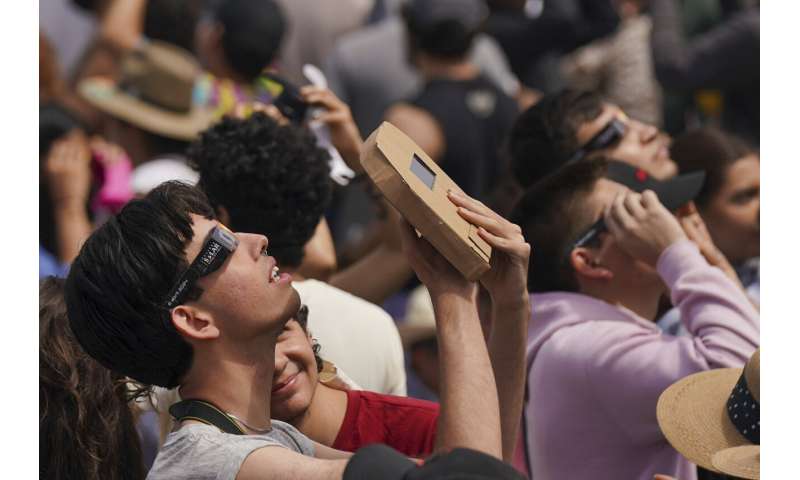
People use special glasses to watch a total solar eclipse in Mazatlan, Mexico, Monday, April 8, 2024. Credit: AP Photo/Fernando Llano -

People watch a total solar eclipse in Mazatlan, Mexico, Monday, April 8, 2024. Credit: AP Photo/Fernando Llano -

A resident of a downtown apartment complex glances out of his window as the eclipse begins over Columbia, Mo., on Monday, April 8, 2024. Credit: Brian W. Kratzer/Missourian via AP -
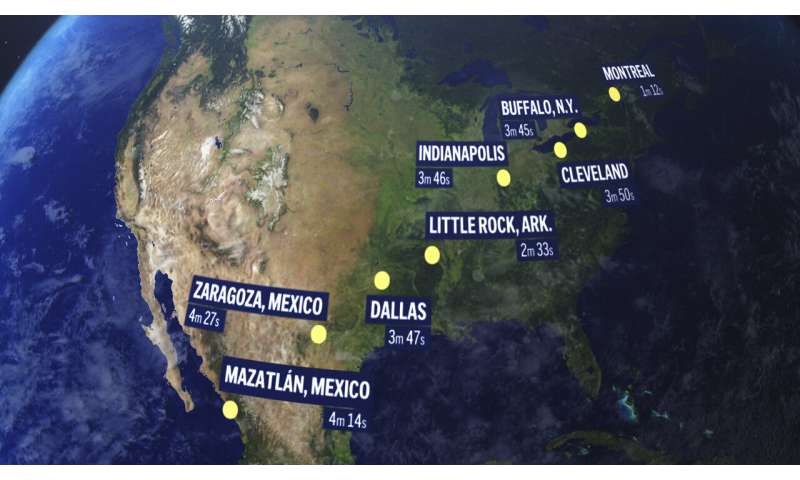
A total solar eclipse April 8 will enter over Mexico's Pacific coast, dash up through Texas and Oklahoma, crisscross the Midwest, Mid-Atlantic and New England, before exiting over eastern Canada into the Atlantic. Credit: AP Photo, File -

People use special glasses to watch a total solar eclipse in Mazatlan, Mexico, Monday, April 8, 2024. Credit: AP Photo/Fernando Llano -
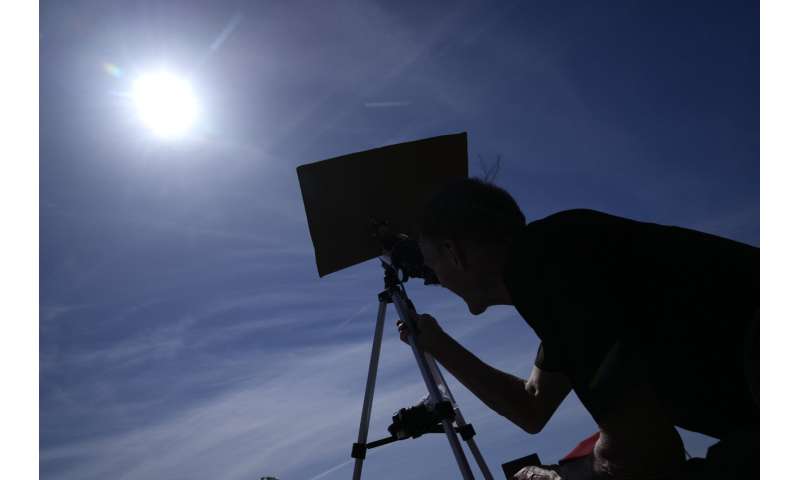
Mike Porter uses a telescope to get a look at the sun as he prepares to watch a total solar eclipse Monday, April 8, 2024, in Carbondale, Ill. Credit: AP Photo/Jeff Roberson -

Solar glasses sit on a table to be used while watching the total solar eclipse Monday, April 8, 2024, in Carbondale, Ill. Credit: AP Photo/Jeff Roberson
Eye protection is needed with proper eclipse glasses and filters to look at the sun, except when it ducks completely out of sight during an eclipse.
The path of totality—approximately 115 miles (185 kilometers) wide—encompasses several major cities this time, including Dallas; Indianapolis; Cleveland; Buffalo, New York; and Montreal. An estimated 44 million people live within the track, with a couple hundred million more within 200 miles (320 kilometers).
"This may be the most viewed astronomical event in history," said National Air and Space Museum curator Teasel Muir-Harmony, standing outside the museum in Washingon, awaiting a partial eclipse.
Experts from NASA and scores of universities are posted along the route, poised to launch research rockets and weather balloons, and conduct experiments. The International Space Station's seven astronauts also will be on the lookout, 270 miles (435 kilometers) up.
© 2024 The Associated Press. All rights reserved. This material may not be published, broadcast, rewritten or redistributed without permission.





















